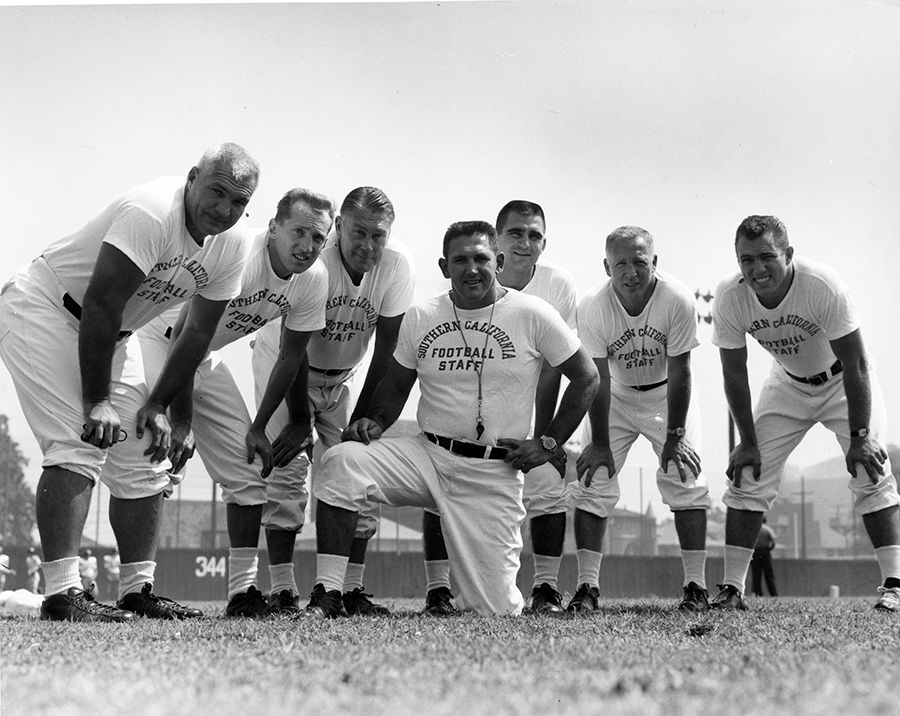As football players went, he was big for his day — 6 feet 2 inches tall, 230 pounds, strong enough to play on the offensive line, not just at Loyola High School, but at the University of Southern California … and for the Detroit Lions, who drafted Ray George in the 10th round of the 1939 National Football League draft and made him their starting right tackle in his rookie season.
With his debut — in a 21-13 Lions’ win over the Chicago Cardinals, on Sept. 10, 1939, at Briggs Stadium in Detroit — the 23-year-old George became the first football player from a Catholic high school in Los Angeles to play in the NFL.
Since then, 161 graduates of Catholic high schools in the Archdiocese of Los Angeles and the Diocese of Orange have played at least one game of pro football, either in the NFL, the former American Football League (1960-69) or both, through 2016. To date, 29 Catholic high schools from L.A. and Orange have been represented, from George of Loyola to linebacker Todd Davis of Paraclete in Lancaster, who in 2014 played for New Orleans and Denver (and started all but one game for the Broncos in 2016).
Several schools, like Loyola, have sent more than a half-dozen players to the pros; others are represented by one or two. As pro football training camps kick into gear this month, Angelus News presents a look at the first player from a local Catholic high school to reach the pros. (A future article will list all 161.)
Trojan glory
Born Jan. 17, 1916 in St. Louis, Raymond Edward George was a member of Loyola’s class of 1935 and the Catholic League champion Cubs football squad, and at USC played for legendary coach Howard Jones. As a senior, he earned the Davis-Teschke Award as the team’s most inspirational player on the 1938 Trojan team that finished 9-2, upset No. 1 Notre Dame at South Bend, 13-0, and stunned previously unbeaten and unscored-upon Duke in the Rose Bowl, 7-3.
As the 87th overall pick in the 1939 NFL draft, George played in all 11 of the Lions’ games that season, although the Sept. 10 season opener, like most everything else, was overshadowed by the darkening events taking place in Europe. That same day, Canada joined England and France in declaring war on Germany, nine days after Germany had invaded Poland (and five days after the U.S. had declared its neutrality in what later become known as World War II).
After his first season, George played just two more games in the NFL, with the 1940 Philadelphia Eagles. He left pro football to coach at Porterville High School in Tulare County, entered the service in 1942 and after the war returned to USC football as an assistant coach in charge of linemen (1946-50).
He served three years as head coach at Texas A&M (compiling a 12-14-4 record), before returning to Southern California as a businessman. (His wins included one over a Kentucky team coached by Paul “Bear” Bryant, who succeeded him at A&M, then earned greater fame at Alabama.)
Another call to the Trojan gridiron led to George’s return as a USC assistant coach from 1958 to 1965, serving as senior assistant under John McKay when the Trojans won the 1962 national title and Rose Bowl with a perfect 11-0 record.
After a successful tenure as vice president of sales for Transamerica Title Insurance Company, George came back to USC football a final time as assistant coach under McKay (1972-74), as USC played in three Rose Bowls and earned two national titles. He also was assistant athletic director until retiring in 1986.
On Jan. 12, 1995, George died from complications of a stroke at age 78. His survivors included his wife of 54 years, fellow USC graduate Martha Folsom, their son Greg, who played football at USC in the late 1960s, and their son Jack.
In 2001, George was named to the USC Athletic Hall of Fame, an occasion for which his family was present. Martha George remained active with the USC Alumni and attended USC football games until she was 90, two years before her death in 2008.
Interested in more? Subscribe to Angelus News to get daily articles sent to your inbox.

